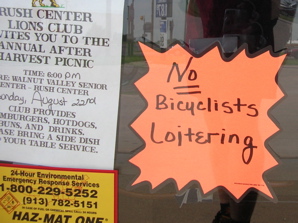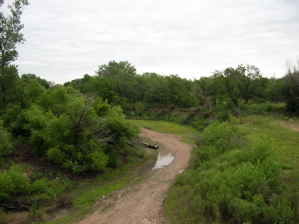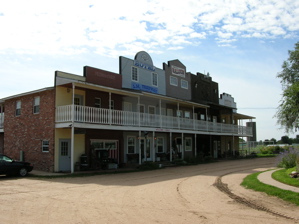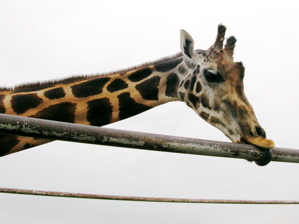|
Alexander to Girard, KS |
|||||
|
|
The town of Alexander recently had a rest area built with rest rooms and picnic tables, and I stopped there to fill my water bottles. Just behind the building was a well preserved example of an early barbed wire fence, complete with limestone posts. As the Native Americans and bison were pushed from Kansas, early settlers found the grasslands perfect for raising and grazing huge herds of livestock. As more ranchers and farmers arrived in the region, farmers began fencing in their properties, destroying the concept of "open range" and leading to many bloody range wars. Eventually, stockmen realized they would have to accept some limits to their domain. There were no trees in the area to provide wood for fence posts, so settlers carved posts from limestone. About 40,000 miles of post rock fence still exist in this area. |
||||
The post rocks, however, made only half the fence. It was the coming of barbed wire in 1847 that solved the fencing problem and changed the lifestyle on the Great Plains. The water from the fountain at the Alexander rest area didn't taste great, so a few miles later when I came to the crossroads of Rush Center, I stopped at the gas station/convenience store there to buy some bottled water and snacks. I was greeted by a large bright sign on the door which read, "No Bicyclists Loitering". Elaine (of Elaine's Bicycle Oasis B & B) had mentioned that some business owners in the area were not fond of the bicyclists that pass through here every season. Many of them, she was told, will walk into a cafe and whip out their own food, then ask for water and ice.
|
 "Welcoming" sign in Rush Center. |
||||
I haven't witnessed any such behavior by bicyclists on my trip, though I'm sure it occurs occasionally. But I don't hold a grudge against the thousands of courteous motorists I've encountered because one ass threw a Fanta can at me. I went inside, and asked the clerk about the sign. "I just started working here", she said. "I don't know anything about it." She looked to me like she had worked there since she dropped out of the seventh grade on her sixteenth birthday. She certainly knew every customer who came into the place. I was hungry and thirsty, the water I had in my bottles tasted like crap, and the next available store was 35 miles ahead. But I couldn't bring myself to spend money there. So, I took off... ...directly into a 20 mph headwind. A jog in my course sent me due south for 19 miles, which took nearly two hours against the wind. Then I turned east again, and pedaled easier with a crosswind. About 30 miles down the road from Rush Center, I came to Fort Larned National Historic Site, a preserved frontier fort that protected settlers traveling during the mid-1800's on the Santa Fe Trail, which passed through this area. The fort was interesting, and reminded me of Fort McHenry in Baltimore, near where Francis Scott Key penned the Star Spangled Banner. Riding towards the town of Larned after leaving the fort, I heard the familiar whining call of the Killdeer. During the train ride west, and the first third of my trip, the most common bird I saw was the Red-winged Blackbird. Since leaving the Tetons the blackbirds have been replaced by the Killdeer, another noisy bird of the wetlands. I have heard or seen them every day during the middle third of my trip. I remember (from my third-grade class's study of birds) that Killdeer will fake a broken wing to lead predators away from their nest. I've tried to instigate this behavior by walking towards a Killdeer nest several times in the past, but have never witnessed it. Riding along the road to Larned, a Killdeer began running ahead of me on the shoulder, holding his right wing at an awkward angle, and stumbling as he ran. Once we had traveled a little way in tandem, he took off and circled back towards his nest. I've finally seen the Killdeer's broken-wing trick, and I didn't even intentionally pester a bird! I checked into a cheap motel in Larned, conveniently located next to a Subway restaurant and a laundromat. After dinner and laundry, I stretched out in the easy chair in my room, and the change fell out of my pocket. Scrounging under the chair, I found more change than I lost. Surely this was a good sign! Maybe I've found my calling. When I get home, I can look for change under hotel room easy chairs for a living. |
|||||
The forecast called for rain most of the next day, Thursday, August 19th. It started out with the wind out of the northeast, ahead and slightly to my left. I've certainly become used to riding with headwinds, but, frankly, I prefer hills. With hills, you get to the top, then you go down. With headwinds, unless you turn around and go the other way, there is no downhill side. Other than headwinds, I enjoy riding in the Great Plains. I have not experienced the plains before this trip, and I find them interesting- certainly not boring. The grain elevators are like fingerprints, or snowflakes- no two are the same. The roads are flat in western Kansas, but get rolly as they enter the area known as the Flint Hills. With no trees in the way, as I crest a rise in the terrain, I can see miles ahead to the top of the next rise. You can take a brief ride with me on the plains by checking out this video. |
|||||
|
Shortly after leaving Larned, I crossed the Arkansas River. The channel I passed over was almost completely dry. In Colorado, the Arkansas River is pronounced as you would expect, just like the state of the same name. As soon as you enter Kansas, the river's name is pronounced "Ar-Kansas". Go figure! Barb and Randall Angell (both originally from Kansas) warned me about this so I wouldn't sound like an idiot, or a tourist, in Kansas. Once I crossed the river, it began to rain- lightly at first, then steadily building. I started out wearing my light rain jacket, which worked well for a while. When the rain got heavier, I put on my British cycle-touring rain poncho for the first time in my journey. |
||||
It worked amazingly well! The front of it was long enough to cover my handlebar bag. The back tucked under my butt. The sides hung down enough to provide some protection to my upper legs. With rain booties over my shoes, wool socks to keep my feet warm even if they got wet, and fenders keeping water from spraying up under the poncho, I was as comfortable as I could possibly be, riding in the rain. With waterproof rain jackets, even Gore-Tex, I've always become as wet from sweat as I would have from the rain. Unlike a jacket, the poncho allowed air to circulate between my body and my outer layer, keeping me from getting soaked from either direction. I rode about 50 miles in steady rain. The novelty of my Poncho had worn off by then. |
|
||||
I got to Nickerson, and pulled up to Hedrick's Exotic Animal Farm and B & B, a place I had heard about from westbound riders. Hedrick's was a real treat. My room had a Jacuzzi in it, and I got three therapeutic soaks in over the 16 hours or so that I was there. The guests, just a family of five from the Kansas City area and I, were treated to a full tour of the facilities, and a camel ride. The variety of animals here is amazing. Giraffes, camels, zebras, ostriches, kangaroos, deer, goats, bison, water buffalo, and "Silky", the female lap-turkey that followed us around begging to be pet. |
|||||
I left Hedrick's late Friday morning, after my camel ride. The weather was better than Thursday. Most of the ride was along the Ar-Kansas river, though it was rarely visible. Late in my ride, I was overtaken by Ray, a strong local cyclist. We chatted as we rode together, and he led me through the town of Hesston (destroyed by an F5 tornado in the 70's, as seen on the Weather Channel's "Storm Stories") where we stopped for ice cream, and into Newton, where I called it a day. Saturday, I stopped for lunch in Cassoday, the "Prairie Chicken Capital of the World". The small café there had a cyclists log book. I was distressed to read that Bonnie (of Frans and Bonnie from Upstate New York) had fallen and injured her leg on some railroad tracks in Hutchinson when a truck didn't leave her enough room on the road, and Frans was continuing alone for the time being. Southeast of Cassoday, the route joined a state highway that had recently been paved. I enjoyed the "happy top", but the traffic moved very fast, and the shoulder was littered with debris that kept me closer to the travel lane than I would have liked. At one point, a VW Jetta deliberately moved to his right to pass close by at high speed. I watched his movement in my rear-view mirror, and moved onto the shoulder to avoid the close call, but it still gave me a start. Maybe Tom Magliozzi of the NPR show "Car Talk" is right when he says "the most reckless, inconsiderate drivers drive a VW Jetta". You can read more of his rant here. This type of occurrence has been so rare, that I almost hate to bring it up in this forum. But it helps to illustrate the dichotomy of Kansas. Along with the family in Tribune who contributed to Amanda, the teachers in Dighton who invited me to join them for lunch, and, of course, Dan and Elaine Johnson, Kansas also has the "No Bicyclists Loitering" sign in Rush Center, and jerks in Jettas. About 20 miles short of my destination, Eureka, I had to stop to fix a flat in my front tire, my ninth of the trip. Front tire flats are relatively rare (since most of the weight is carried by the rear tire), but much faster to fix than rear flats. I don't have to turn the bike upside-down. I can remove the front panniers and the tire, and rest the bike on the front racks while I repair the flat. I found the hole, but I couldn't find the source of the problem. Usually, the thorn, piece of glass, or whatever caused the puncture remains in the tire, and must be removed. But once in a while, it removes itself before you can find it. I spent a minute or two searching, then gave up and just patched the tire. I hoped it would get me to Eureka without another flat. You see, I was in a hurry. I had to go to the bathroom in a big way, and there were no open facilities at all in the 40-mile stretch between Cassoday and Eureka, and no woods or anywhere to hide off the road. I had tried to go in Cassoday, but the bathroom there had a big sign on the wall saying "No paper in the toilet at all... Not even TOILET PAPER!". And that wouldn't do. I got about five miles before the tire went flat again. This time, I found the perpetrator- a tiny piece of wire about 1/8th of an inch long. I patched the tire quickly, and made it to Eureka. Barely! I walked down the street from my dive motel to a restaurant recommended by the motel owner. I was starving. I walked in, and a hostess looked up and said, "I'm sorry Sir, we closed at 8:30." I looked at my watch. It was 8:32- the Rite Aid Pharmacy in Denver all over again. There were still plenty of people in the place. Some hadn't even been served, yet. "I'm pretty hungry", I said. "And I tip well. Are you sure?" "Yes Sir, I'm sorry". Fine! I went next door to the "Chuckwagon Truck Stop Cafe", and had a fine chicken-fried steak. I even went back there Sunday morning for breakfast, after fixing another flat in the motel room, my 11th! My quick patch job from the evening before hadn't held. I had a beautiful, slightly hilly 70-mile ride to Chanute on Sunday, passing through Toronto State Park. On the way into the town of Chanute, I passed a large restaurant with a huge billboard of a sign out front that read. "Chanute Grill- A Vegetarian's Nightmare!!" But it was out-of-business, so I guess the vegetarians had the last laugh. I spent the night in Chanute, and picked up some mail at the post office Monday morning. 40 miles into my ride on Monday, I stopped for lunch at "Boots and Saddle" in the tiny hamlet of Walnut, where I had a surprisingly pleasant experience. The food was good, and the service excellent and friendly. The chef brought out a log book for me to sign. Frans had stopped there, and signed "Frans, and Bonnie in spirit". It was upsetting to hear about a fellow rider unable to complete a long-planned journey. Also in the book, and less than a week ahead of me, were Mary Scott and Bob, whom I had met on the bus from Portland to Astoria. They were only riding as far as Farmington, MO, having ridden the eastern half of the TransAm a while ago, so I doubted that I would be able to catch up with them. But I would give it a shot. Not long after I left Walnut, I spied the first Scissor-tailed Flycatchers I'd ever seen. Their appearance is striking, with their long, forked tails. Several of them played "tag" with me, landing ahead of me on the roadside fence, then leapfrogging ahead of me again when I passed. |
|||||
Later, I passed a herd of wild mustangs that was managed by the Bureau of Land Management. I had passed several of these herds in the last few weeks. Every year, the BLM rounds them up and sells some of the offspring to keep the herds from outgrowing their resources. This reminded me of the story of "Misty of Chincoteague", and the Assateague Island ponies that are rounded up once a year for the same purpose. You can read more about their program, and even adopt a horse, here. You can watch a brief video of these horses as they run beside me here. I rode through Girard late in the day on Monday, August 23rd, headed for Pittsburgh, KS, for the night. |
|||||





